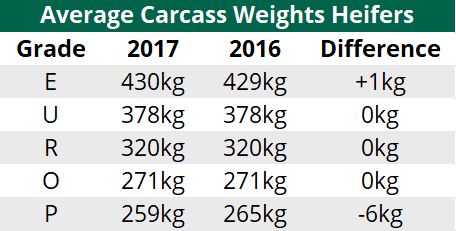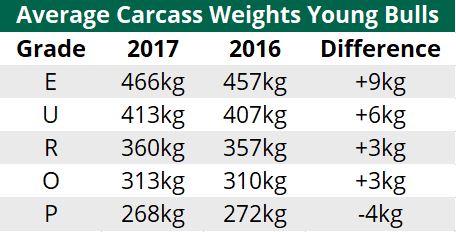Recent figures have revealed the extent to which O and P-grade animals – dairy-origin stock in other words – have dominated the Irish beef kill in 2017.
During the past year, almost 1.74 million cattle were slaughtered in Department of Agriculture, Food and Marine approved beef export plants. This figure encompasses young bulls, aged bulls (24+ months), steers, heifers and cows.
An analysis of figures taken from the department has shown that approximately 55% – the equivalent of 966,116 head – of these cattle were classified as being either O or P-grade at the time of slaughter.
In addition, E-grade cattle accounted for the lowest proportion of the total kill throughout 2017. Just 5,974 cattle – or 0.3% of the total kill – reached the highest grade possible on the grid during this time.
Furthermore, U and R-grade stock – which represent the vast majority of suckler-origin cattle – made-up 12.5% (217,626 head) and 31.6% (549,885 head) of the 2017 beef kill respectively.
How does it compare to 2016?
Comparing data from both 2017 and 2016, it’s clear that the quality (carcass grades) of Irish cattle has failed.
For the duration of 2016, O and P-grade animals accounted for 51.8% of the national kill – 2% lower than number presented for slaughter last year.
Furthermore, the number of cattle falling within the top classification – E-grade – was also higher in 2016; plus, it accounted for 0.4% of all animals slaughtered in approved plants.
Delving deeper into the figures, it is clear that there has been a significant decline in the number of animals falling within U and R-grade categories. In 2016, 14.2% of the cattle slaughtered slotted into the U-grade category. However, this dropped to just 12.5% in 2017.
Breakdown by category
Carcass weights
Steers
With regards to the average carcass weights for steers in 2017 and 2016, the biggest difference was witnessed in P-grade animals – dropping by 9kg year-on-year.
O-grade cattle, on the other hand, remained static. Increases of 1kg, 2kg and 4kg were witnessed in E-grade, U-grade and R-grade animals respectively.
Heifers
Between 2016 and 2017, there was very little difference when the average carcass weights of heifers were examined; no movement was recorded in U-grade, R-grade and O-grade animals.
A slight increase of 1kg was noted in top-graded (E) heifers in 2017 compared to the previous year. At the other end of the scale, the average weight of P-grade heifers dropped by 6kg in the year just gone.
Young bulls
The average carcass weights of the higher grades of young bulls all increased in 2017. E-grade, U-grade and R-grade animals recorded increases of 9kg, 6kg and 3kg respectively – compared to the previous 12 months.
An increase of 3kg was noted in the average weight of O-grade young bulls. However, it wasn’t all positive; the average weight of P-grade animals dropped by 4kg in 2017 versus 2016.
‘Borderline animals’
Edmund Graham, the newly-elected beef chairman of the Irish Cattle and Sheep Farmers’ Association (ICSA) said the increase in dairy kill adds further fuel to arguments for a full overhaul of the beef grid system.
Although he acknowledges that there may be more dairy animals on the grid, he believes the crux of the issue is the system itself.
Speaking to AgriLand, he said: “Some of the borderline animals are slipping down because the grading machines just aren’t doing their job; they’re not efficient. I believe the grading system holds most of the blame.
“I know personally myself from slaughtering my own cattle that my grades aren’t as good – it’s not just because of dairy stock,” he said.
Grid system review
The Monaghan man said there needs to be a full review of the grading system.
First of all the actual machine needs to be looked at. At this stage, I would say they need to be replaced. They’ve done their time, they are there for the last 10 years.
He contends that the price structure on the grid also needs to be scrutinised.
“The men with the better-quality animals are still not getting paid for them; it’s not making enough of a difference.
“We all know dairy-bred stock have increased; but, the live shipping is taking a certain amount of those calves out of the country, so the increase is not all down to dairy-bred stock,” he concluded.





